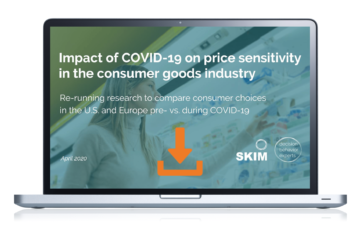The current crisis has triggered many changes in consumer behavior. Some of these behavioral shifts are obvious, for example, the growth in online shopping. While others, such as the impact on price sensitivity, are less certain. You may be wondering:
Should I conduct pricing or portfolio research now? Can I rely on study results in this rapidly evolving market?
The ultimate answer to these questions depends on whether you have the right information to inform your decisions. Currently, the balancing act is on making tactical COVID-specific decisions versus long-term strategic decisions. To inform these decisions, assumptions need to be made whether consumer behavior is changing (back) in the future. These assumptions can be based on past learnings (experience), but we believe that especially now, it is crucial to also base decisions on facts and verify these with multiple data sources where possible.
A data-driven approach to decision making
From executing hundreds of pricing and portfolio studies each year – in “normal times” and in times of crisis – we know that it is almost impossible to get a single-minded point of view on what the end goal for your business should be; Volume? Revenue? Profit?
This is where the power of data and hard facts come into play; run “what if” and competitive scenarios and overlay this with as many data sources as possible. A wide data set, such as sales data, brand trackers, marketing mix models, expert views, and consumer insights will help you make the best pricing and portfolio decision.

For example, in “normal” times, trended sales data combined with information on promo pressure can give us robust indications for what to expect when making changes in store or online. And when going outside of known parameters, we can supplement data with research among shoppers to understand how they would react to triggers such as an innovation, new promotions or new prices etc.
COVID-19 presents us with a situation where consumer purchasing habits have been disrupted and sales data which have glitches that any forecasting-model dislikes, based on hoarding and disrupted shopping frequencies. This means we’re operating more outside of ‘known parameters’ and face more uncertainty. As a result, we need to supplement our understanding from other sources more.
3 tips for making pricing decisions during COVID-19
Here are three recommendations for how you can tackle pricing decisions now:
1. Collect information from a variety of “experts”
Different external sources can inform the pricing scenarios you are considering. Publications from consultancy houses, trade organizations, and industry experts are good starting points.
2. Zoom in on unexplained model variations
Determine which variations in your models you can explain and brainstorm on arguments which could shed light on the unexplained variation. Consider reaching out to your shoppers directly to get a better understanding. You can keep it as simple as doing interviews with a few customers, or set up more extensive research.
3. Keep feeding your scenarios with data
Whereas before COVID-19 you might have been able to base decisions on a one-off check, the shelf life of old pricing research will be much shorter. Consumer consumption and their “willingness to pay” for certain products and services can change from one day to the next depending on lockdown restrictions, travel bans, news, and economic conditions.


Especially based on the last point, it is a tough decision to warrant investment in pricing or portfolio research. We recently conducted a  and found that in most cases, much of the consumer preferences and purchase behavior has remained consistent pre and during COVID-19. However, the effect of consuming everything at home, together with economic insecurity has immediate implications, for instance for manufacturers who don’t offer large pack sizes in their portfolio.
and found that in most cases, much of the consumer preferences and purchase behavior has remained consistent pre and during COVID-19. However, the effect of consuming everything at home, together with economic insecurity has immediate implications, for instance for manufacturers who don’t offer large pack sizes in their portfolio.
We believe these are valuable and critical insights to have. At the same time with the increased focus on health and hygiene, and shelf space disappearing to allow for social distancing, cases need to be built to convince retailers of your assortment suggestions – ideally based on current facts.
Key takeaway for pricing and insights professionals
Sound research and data are critical to inform pricing decisions in the short- and long-term, especially in times of disruption. Now, more than ever, brands that are maintaining a competitive edge have adopted an agile approach to pricing research. They recognize that relying on a robust pricing model with a validity of perhaps less than three months is not sustainable. Instead, they have shifted their insights strategy to keep a finger on the pulse of consumer behavior now and in the coming months.
For example, we are partnering with some brands to re-run the same pricing study in multiple waves. By comparing the same conjoint analysis – for example during COVID, in three and in nine months time – they will be able to track any changes and adapt their pricing strategy in a dynamic and uncertain market. This effective and efficient approach will also better equip you for tough retailer negotiations during the recession, because “retailers are likely to want to reevaluate their category vision and assortment” (McKinsey, April 2020).
If you’re interested in learning more about doing pricing research in times of disruption, contact us and we can discuss how we could tailor it for your needs.
Impact of COVID-19 on consumer price sensitivity in the US and Europe
 Visit our COVID-19 and Decision Behavior Disruption knowledge center for more content in this series.
Visit our COVID-19 and Decision Behavior Disruption knowledge center for more content in this series.
We are sharing additional theories, best practices and tips on decision-making, eCommerce, innovation, and revenue management strategies. Our goal is to provide inspiration, answers to common questions we’re receiving and help you navigate the new normal.

